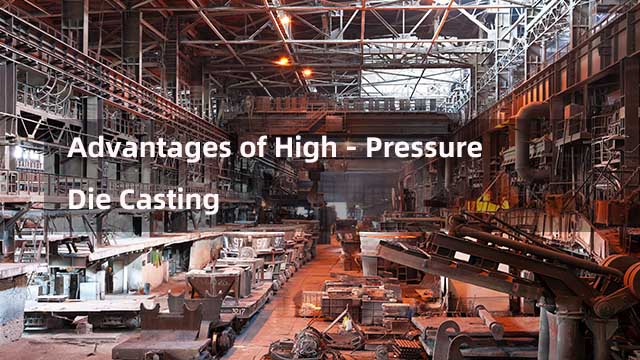Advantages of High - Pressure Die Casting
2025-02-10 10:36:16 hits:0
In the landscape of modern manufacturing, high - pressure die casting has emerged as a dominant process, offering a plethora of advantages that have transformed the production of metal components across diverse industries.

1. Exceptional Precision and Complex Geometry Realization
High - pressure die casting is renowned for its ability to produce parts with remarkable dimensional accuracy. Tolerances can be maintained within tight limits, often in the range of ±0.1mm or even less for some highly - engineered components. This high - precision output is a result of the high - pressure injection mechanism. When the molten metal is forced into the die cavity at pressures ranging from 10 to 150 megapascals, it fills every intricate detail of the mold with extreme accuracy.
This advantage is particularly evident in the production of components for the aerospace industry. For example, the manufacturing of wing brackets requires complex shapes with multiple holes, slots, and curvatures. High - pressure die casting enables the creation of these parts with the exact specifications, ensuring seamless integration into the aircraft structure. In the electronics industry, the production of smartphone housings demands not only precision in dimensions but also the ability to create thin - walled structures with complex internal ribs for strength and heat dissipation. High - pressure die casting meets these requirements effortlessly, providing a smooth and aesthetically pleasing finish.
2. Unparalleled Production Efficiency
The high - pressure die - casting process is highly automated, which significantly boosts production efficiency. The rapid filling and solidification times are key factors contributing to high - volume production. In a typical automotive manufacturing plant, high - pressure die - casting machines can produce hundreds of parts per hour. For instance, engine blocks, which are complex and high - volume components, can be churned out at an impressive rate.
The quick cycle times also mean that manufacturers can respond rapidly to market demands. In case of a sudden increase in the demand for a particular automotive part, high - pressure die - casting facilities can ramp up production without significant delays. This efficiency not only reduces production costs per unit but also allows companies to stay competitive in the global market by offering shorter lead times.
3. Superior Mechanical Properties
Parts produced through high - pressure die casting exhibit excellent mechanical properties. The high - pressure injection process compresses the molten metal, resulting in a fine - grained microstructure. This fine - grained structure leads to enhanced strength, hardness, and fatigue resistance.
Take the example of components used in the oil and gas industry. Valves and fittings produced by high - pressure die casting need to withstand high - pressure fluids and harsh environmental conditions. The high - strength and fatigue - resistant nature of the cast parts ensure their long - term reliability and durability. In the automotive industry, transmission cases made through this process can endure the high - torque forces and vibrations during operation, contributing to the overall performance and longevity of the vehicle.
4. Material Utilization and Cost - Effectiveness
High - pressure die casting is relatively efficient in terms of material utilization. Since the molten metal is precisely injected into the die cavity, there is minimal waste. The process allows for the production of near - net - shape parts, which means that only a small amount of post - processing, such as trimming and machining, is required. This reduces the overall material cost and production time.
Moreover, the high production volume enabled by high - pressure die casting leads to economies of scale. The initial investment in high - pressure die - casting equipment can be substantial, but as the production volume increases, the cost per unit decreases significantly. This makes it a cost - effective option for large - scale production runs.
5. Design Flexibility
Designers have a great deal of flexibility when using high - pressure die casting. The process allows for the integration of multiple features into a single part. For example, in the production of a complex industrial pump housing, features such as internal channels for fluid flow, mounting bosses, and reinforcement ribs can all be incorporated into the design and produced in one casting operation. This eliminates the need for multiple assembly steps and reduces the number of components, leading to a more streamlined and cost - effective manufacturing process.
In conclusion, high - pressure die casting offers a comprehensive set of advantages that make it an indispensable process in modern manufacturing. From its ability to create highly precise and complex parts to its high production efficiency and superior mechanical properties, it continues to drive innovation and growth in industries such as automotive, aerospace, electronics, and many others. As technology continues to advance, these advantages are likely to be further enhanced, opening up new possibilities for the production of even more advanced and sophisticated metal components.

 en
en  fra
fra  de
de  ru
ru  gle
gle  th
th  ara
ara  it
it  jp
jp  kor
kor  zh
zh 


